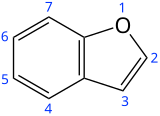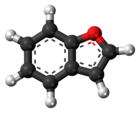Benzofuran
Benzofuran je heterociklično jedinjenje koji se sastoji od kondenzovanih prstena benzena i furana. Ova bezbojna tečnost je komponenta katrana. Benzofuran je osnova mnogih srodnih jedinjenja sa kompleksnijim strukturama. Na primer, psoralen je derivat benzofurana koji se javlja u nekoliko biljki.
| Benzofuran | |||
|---|---|---|---|

| |||
 |
 | ||
| IUPAC ime |
| ||
| Drugi nazivi | Kumaron, benzo[b]furan | ||
| Identifikacija | |||
| CAS registarski broj | 271-89-6 | ||
| PubChem[1][2] | 9223 | ||
| ChemSpider[3] | 8868 | ||
| UNII | LK6946W774 | ||
| DrugBank | DB04179 | ||
| KEGG[4] | |||
| ChEBI | 35260 | ||
| ChEMBL[5] | CHEMBL363614 | ||
| Jmol-3D slike | Slika 1 | ||
| |||
| |||
| Svojstva | |||
| Molekulska formula | C8H6O | ||
| Molarna masa | 118.13 g mol−1 | ||
| Tačka topljenja |
-18 °C, 255 K, -0 °F | ||
| Tačka ključanja |
173 °C, 446 K, 343 °F | ||
| Opasnost | |||
| LD50 | 500 mg/kg (mice).[6] | ||
|
Ukoliko nije drugačije napomenuto, podaci se odnose na standardno stanje (25 °C, 100 kPa) materijala | |||
| Infobox references | |||
Produkcija uredi
Benzofuran se može ekstrahovati iz katrana. On se takođe dobija dehidrogenacijom 2-etilfenola.[6]
Laboratorijski metodi uredi
Benzofuran se može pripremiti putem O-alkilacije salicilaldehida sa hlorosirćetnom kiselinom i naknadnom dehidratacijom nastalog etra.[7] U drugom metodu zvanom Perkinovo preuređenje[8][9][10] kumarin reaguje sa hidroksidom:
Srodna jedinjenja uredi
Reference uredi
- ↑ Li Q, Cheng T, Wang Y, Bryant SH (2010). „PubChem as a public resource for drug discovery.”. Drug Discov Today 15 (23-24): 1052-7. DOI:10.1016/j.drudis.2010.10.003. PMID 20970519.
- ↑ Evan E. Bolton, Yanli Wang, Paul A. Thiessen, Stephen H. Bryant (2008). „Chapter 12 PubChem: Integrated Platform of Small Molecules and Biological Activities”. Annual Reports in Computational Chemistry 4: 217-241. DOI:10.1016/S1574-1400(08)00012-1.
- ↑ Hettne KM, Williams AJ, van Mulligen EM, Kleinjans J, Tkachenko V, Kors JA. (2010). „Automatic vs. manual curation of a multi-source chemical dictionary: the impact on text mining”. J Cheminform 2 (1): 3. DOI:10.1186/1758-2946-2-3. PMID 20331846.
- ↑ Joanne Wixon, Douglas Kell (2000). „Website Review: The Kyoto Encyclopedia of Genes and Genomes — KEGG”. Yeast 17 (1): 48–55. DOI:10.1002/(SICI)1097-0061(200004)17:1<48::AID-YEA2>3.0.CO;2-H.
- ↑ Gaulton A, Bellis LJ, Bento AP, Chambers J, Davies M, Hersey A, Light Y, McGlinchey S, Michalovich D, Al-Lazikani B, Overington JP. (2012). „ChEMBL: a large-scale bioactivity database for drug discovery”. Nucleic Acids Res 40 (Database issue): D1100-7. DOI:10.1093/nar/gkr777. PMID 21948594.
- ↑ 6,0 6,1 Collin, G.; Höke, H. (2007). „Benzofurans”. Ullmann's Encyclopedia of Industrial Chemistry. Weinheim: Wiley-VCH. DOI:10.1002/14356007.l03_l01.
- ↑ Burgstahler, A. W.; Worden, L. R. (1966), „Coumarone”, Organic Syntheses 46: 28; Coll. Vol. 5: 251
- ↑ Perkin, W. H. (1870). „XXIX. On some New Bromine Derivatives of Coumarin”. Journal of the Chemical Society 23: 368–371. DOI:10.1039/JS8702300368.
- ↑ Perkin, W. H. (1871). „IV. On some New Derivatives of Coumarin”. Journal of the Chemical Society 24: 37–55. DOI:10.1039/JS8712400037.
- ↑ Bowden, K.; Battah, S. (1998). „Reactions of Carbonyl Compounds in Basic Solutions. Part 32. The Perkin Rearrangement”. Journal of the Chemical Society, Perkin Transactions 2 1998 (7): 1603–1606. DOI:10.1039/a801538d.